Advertisement
Look after your marine battery, and it will serve you when you need it. Here is what you need to know.
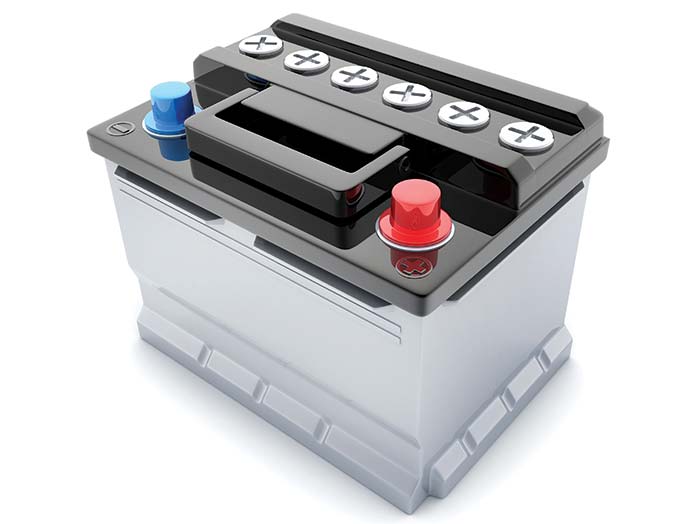
Photo: Thinkstockphotos.com/vladru
If a boat's wiring is the lifeblood of your boat's DC electrical system, then the battery is its heart, and your boat needs a healthy heart. But unlike the battery in your motor vehicle, which is probably used (and charged) fairly frequently, boat batteries can sit dormant for weeks or months at a time, which can lead to a dead battery when you want to use your boat.
Batteries 101
Let's start with your options. There are essentially three types of marine batteries: absorbed glass mat (often called AGM for short), gel cell, and lead-acid. By far the oldest and most common type, and least expensive, is lead-acid. In these batteries, lead plates are suspended in a solution of sulphuric acid, called an electrolyte. AGM and gel batteries each have an electrolyte, too, but instead of being in a liquid form, it is retained as either a jelly (gel cell) or in an acid-saturated fiberglass mat (AGM). One advantage to these is that there's no need to periodically top up the electrolyte as with conventional lead-acid batteries. Other advantages to AGM and gel batteries: they're deep cycle, have a low self-discharge rate, and are safe for use in limited-ventilation areas because they're closed. But they cost two to three times more than lead-acid models.
Tip
Topping up a lead-acid battery is necessary because, as the battery is charged, some of the electrolyte is converted to hydrogen gas and the level diminishes. The battery must be topped up using distilled water, and extreme care should be exercised when performing this maneuver. First, never look directly into the battery when the filler caps are removed, especially if the battery is being charged. Bubbles rise to the surface, and a popping bubble could splash acid into your eye. When working around any batteries wear eye protection, don't smoke, and remove jewelry. A battery may only be 12 volts, but a short across the terminals will produce enough energy to melt metal. To get the most power from your battery, it's essential that the connections to the terminal posts are clean and well made. Poor connections will increase electrical resistance causing voltage drop, which results in your electrical equipment — including your starter motor — not working as designed, or in some cases, not working at all.
Meter Reader
A digital multimeter is a handy tool to accurately check the charge of your battery. Set the meter to DC volts. The meter likely has different ranges, but the 20-volt scale is probably appropriate for typical marine batteries. Place the probes onto the battery terminals and note the reading. A slight difference in the numbers can have a big effect on the battery performance.
- 12.65 to 12.77 volts indicates your battery has a full charge
- 12.45 to 12.54 volts means you have a 75-percent charge
- 12.24 to 12.29 volts is 50-percent charged
- 11.99 to 12.06 volts is 25-percent charged
- 11.75 to 11.89 volts means your battery is dead
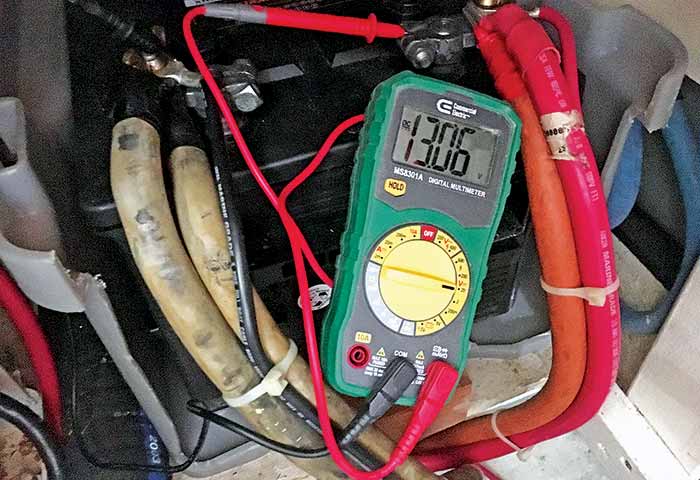
A digital voltmeter is a useful tool for checking a battery's state of charge.
For the most accurate reading, the test should be performed after the battery has been left to rest for 12 hours with no load applied. Readings will be higher immediately after shutting down the engine or immediately after you've disconnected a battery charger. That's because the plates inside a battery accept what's known as a "surface charge," which will give a false reading, one that's higher than the settled reading. If you're short on time, one quick method for getting a reasonably accurate reading on a just-charged battery is by bleeding off the surface charge. To do that, simply run a 2- to 3-amp load (try switching on the running lights) for a couple of minutes, let the battery rest for a couple more minutes, then check the voltage. You can get the most accurate reading of a battery by checking it under load. Get a helper to crank the starter while you hold the multimeter on the battery terminals and note the reading. If the reading drops to less than 9.6 volts, the battery is on the way out. Replace it soon.
If you have a lead-acid battery, you may consider using a battery hydrometer to obtain an accurate reading. This simple, inexpensive tool sucks up a small amount of electrolyte and measures the specific gravity of the fluid. This offers an extremely reliable reading of your battery's health. While a hydrometer will give very accurate results, use care as you're dealing with battery acid. Read, understand, and closely follow the instructions that come with the hydrometer to obtain true results.
Mounting Batteries
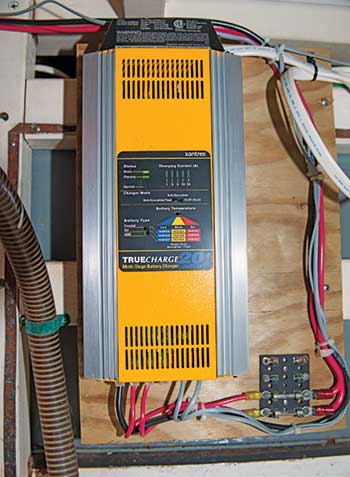
This is a properly installed permanent marine battery charger
with user-settable charging profiles for different types of
batteries.
Batteries must be correctly mounted for them to give safe and effective performance. I've lost count of the number of times I've been on a boat in my capacity as an accredited marine surveyor only to see a battery held in place only by the cables that connect it to the terminals. Apart from the stress that this can impart on the cables and terminals, it's dangerous. A shifting battery could contact some metal part of the boat and cause a short circuit that starts a fire. All batteries should be secured in an acid-proof box or tray to contain spills. A box also isolates the battery from physical harm that could split the case and cause acid to leak out. Positive terminals should be covered as well. Most boxes have covers that serve this purpose.
Charging Batteries
The best thing that you can do for your batteries is to keep them properly charged. All batteries will self-discharge if left to sit. The discharge rate varies depending on the type, size, and age of the battery. A lead-acid battery may lose 5 percent of its charge per month, so it's important that a battery not used for some time, over the winter for instance, is periodically charged to bring it up to full capacity.
How a battery is charged is critical to its health and longevity. Both overcharging and undercharging will reduce the battery's lifespan and degrade its performance. If you use a cheap auto-parts-store battery charger, there's a chance you could severely overcharge or "cook" off the electrolyte, ruining the battery. BoatUS recommends a marine smart battery charger, which is designed for permanent installation, can safely be left connected to the batteries, and will automatically reduce the charge to avoid overcharging.
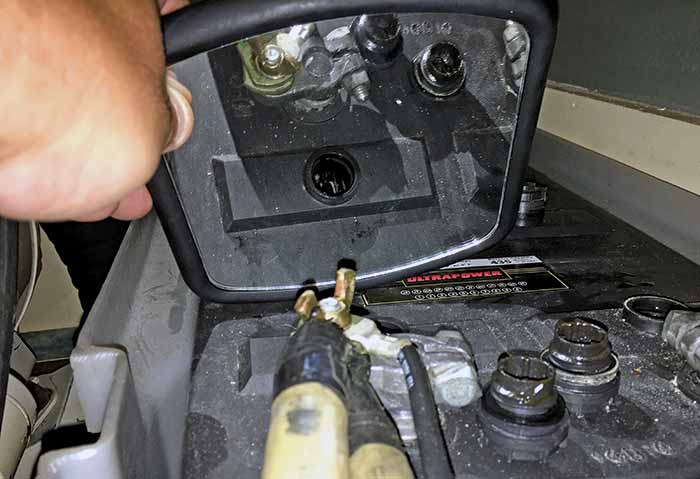
A mirror is handy for seeing into the top of batteries and visually checking the electrolyte if space is tight.
Better chargers offer three-stage charging: bulk, absorption, and float. These stages will keep the battery in its best condition and ensure that it's not overcharged. When a battery is being charged, the first, or bulk, stage puts the greatest amount of charge into the battery. When it's about 85-percent charged, a battery is unable to accept as much current, so the charger goes into absorption mode. The battery still accepts a charge but at a much slower rate, so topping off that last 15 percent takes some time. When the battery charger senses that the battery is fully charged and will accept no further current, it reverts to float mode; the charging current is very slight, just enough to keep the battery in a fully charged condition.
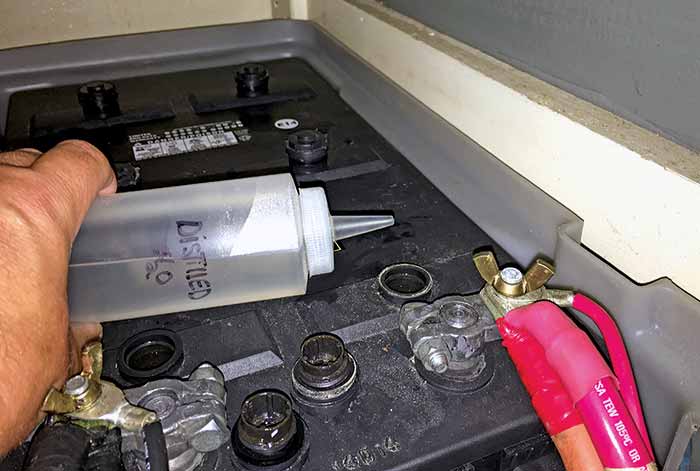
Flooded lead-acid batteries should have electrolyte levels topped up with distilled water. Tap water has too many impurities and shouldn't be used.
This type of smart charger uses selectable charge regimens based on the type of battery being charged. It's important that the charger is set for the corresponding type of battery, or you risk damaging the battery. Some chargers also allow the user to set them for battery temperature and/or ambient air temperature. This feature should be utilized for maximum charging. Read the manual for your battery charger to better understand its functions.
Batteries can be charged from multiple sources. Apart from receiving charge current from the engine alternator and shore-power chargers, batteries may also receive charging current from devices such as solar panels and wind generators. Simply connecting up a solar panel or wind generator to the battery is a bad idea and can result in overcharging or back-feeding power from the battery. In both cases, as well as with other charging sources, using a smart regulator in the circuit will help to protect the batteries and insure a proper charge. A marine smart charger will have its "onboard regulator," giving you peace of mind. The takeaway from all this? Make sure your batteries are properly charged at all times, don't over or undercharge them, and they'll reward you with years of trouble-free and dependable service.
Lithium-ion Batteries
These days, lithium-ion, or Li-ion, batteries are common. Your laptop and cellphone almost certainly have one, and billions are sold each year.
For the most part, they have a pretty good safety record. But not long ago, the entire fleet of Boeing 787 Dreamliners was grounded due to Li-ion battery fires, and there are frequent reports of smaller fires from devices that use these batteries.
The recreational-boating market has begun offering these batteries to boat owners. Sailors in particular like the weight savings of as much as 75 percent. But because these batteries are a new technology, no standards yet exist that specifically address how to install or maintain Li-ion systems in recreational boats, and some owners are blithely installing them without regard to their unique properties.
Li-ion batteries must have sophisticated battery-management systems and unique overcurrent protection; they can't simply be dropped in to replace conventional batteries. Doing so can cause Li-ion batteries to experience "thermal runaway," a polite way of saying they can catch fire and are almost impossible to extinguish.
If you're going to explore using these, make sure you buy one from a reputable manufacturer and it comes with an approved battery-management system.
Get The Most From Your Batteries
1. Ensure that connections to the batteries are clean, bright, and well made. ABYC guidelines state that there shall be a maximum of four direct connections to any battery post.
2. Prevent short circuits by making sure that there is a lid on any battery box or boots on the battery terminals. Also, be careful with tools. I accidentally dropped a wrench across the two terminals once and almost set the boat on fire.
3. Keep the battery compartment well ventilated. Gasses escaping from the battery, particularly from overcharged lead-acid batteries, can be explosive.
4. Lead-acid batteries need topping up from time to time. After removing the caps, use a flashlight to check the level. Never use a match or open flame as it could cause an explosion. Top off the electrolyte if needed so that it just covers the top of the plates, or to the levels recommended by the manufacturer, before replacing the caps. Immediately wipe up any spills from the top of the battery.
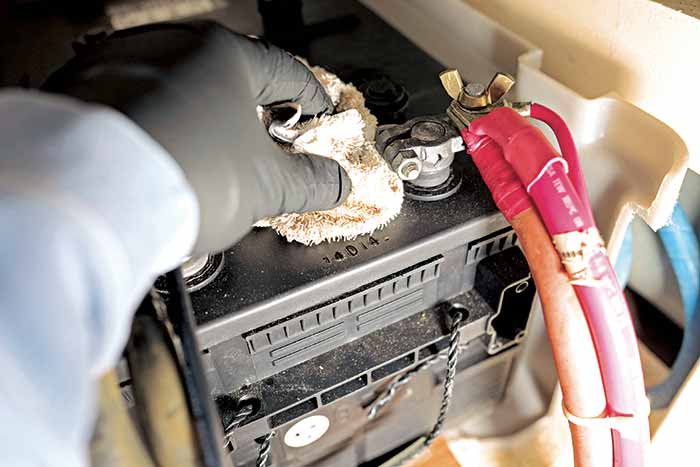
5. When working around batteries, wear gloves to protect your hands from acid, and avoid getting acid on clothing.
6. Stick with one battery type for your boat. Mixing different types together could lead to over- or undercharging, which will shorten the life of your battery bank.
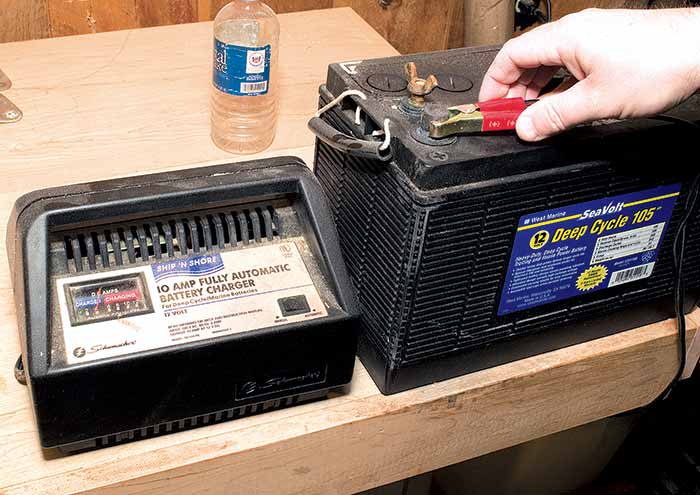
Car-type chargers are inexpensive but can overcharge marine batteries, which shortens their life.
7. If you're going to install a battery charger on your boat, make sure it's a "smart" three-stage marine unit, that offers a sophisticated charging regime. Cheap auto parts store chargers may, with long-term use, shorten battery life.
8. Isolate your batteries when you leave the boat. By turning off the battery master switch, you'll ensure that there are no parasitic loads depleting your batteries while you're away. Properly installed bilge pumps and carbon-monoxide alarms are often wired directly to the battery, so turning off the isolator will not stop those from working.
9. Clean the tops of the batteries as part of routine servicing. A dirty battery can self-discharge to ground given enough dirt and the right circumstances. If white powder builds up on the terminals, clean it off with a baking-soda solution, which neutralizes any acid.
10. When hooking up a battery, ensure that you connect the terminals the correct way. Getting them mixed up could damage electrical components on the boat. Always remove and reinstall the negative (black) cable first.
